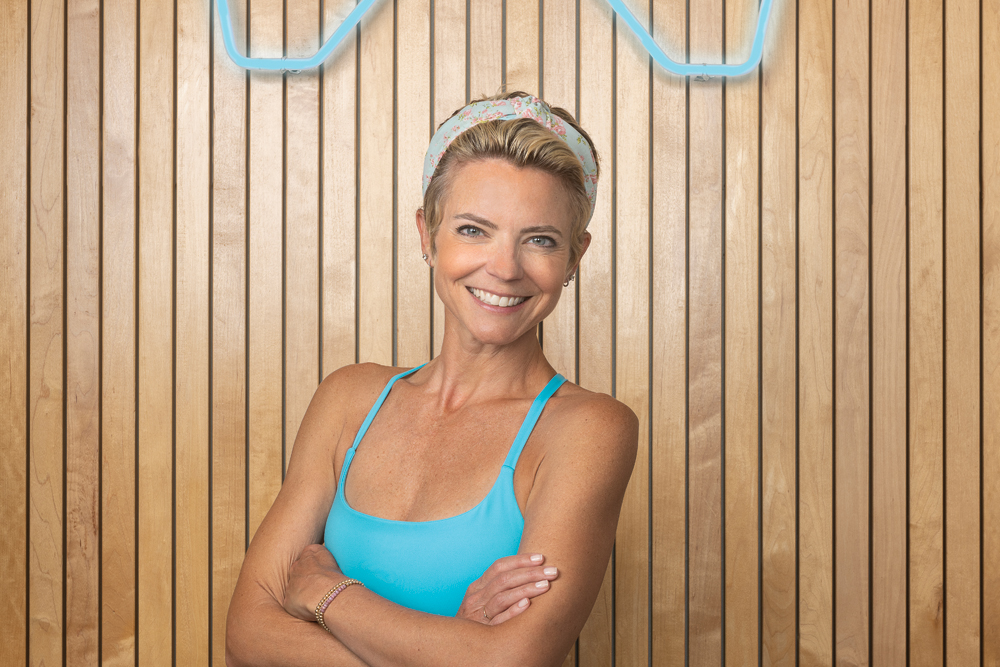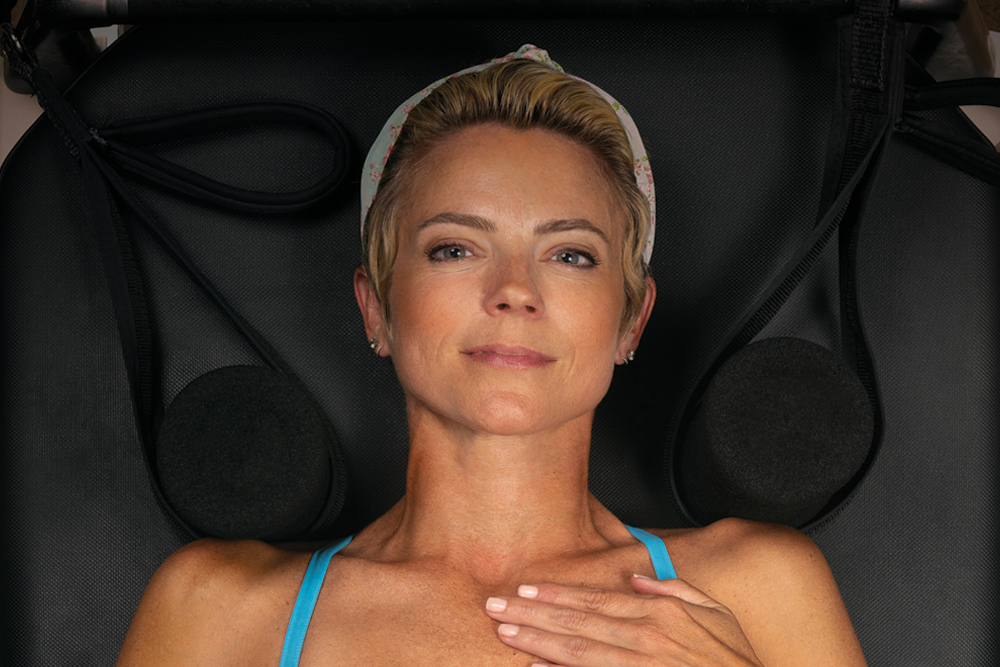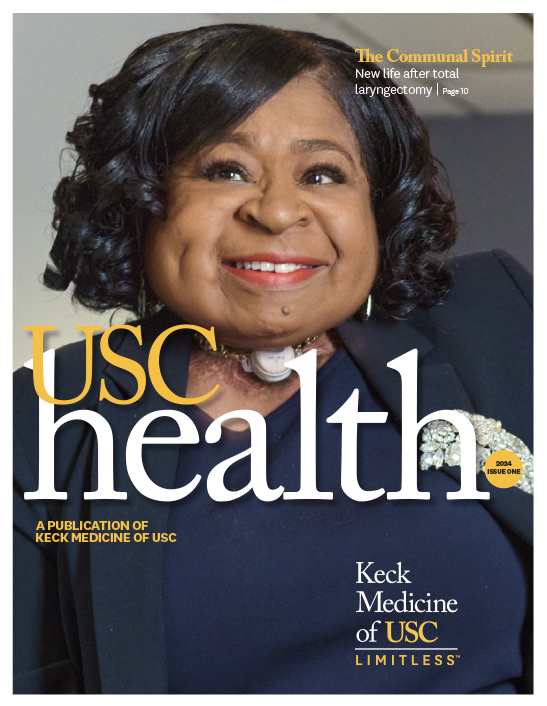
After an initial diagnosis of simple cervical cancer, Amy Jordan sought a second opinion from USC Norris Comprehensive Cancer Center — a move that Amy says saved her life.
As a master Pilates instructor and founder of WundaBar Pilates, Amy Jordan’s health and fitness are a major focus in her life.
So when she began to have pelvic pain and had an episode of unexpected bleeding in May of 2020, she immediately made an appointment to see her gynecologist. That set her on a journey that would bring her to Keck Medicine of USC and the oncologists at USC Norris Comprehensive Cancer Center.
Although Amy had a Pap smear just a few months earlier that did not suggest cancer, when her doctor performed a second pelvic exam in May there was a cervical mass that biopsies confirmed was cancerous. He referred her to a gynecologic oncologist for treatment.
Second opinion for cervical cancer reveals a more serious diagnosis
The first gynecologic oncologist she saw confirmed her cancer diagnosis but gave her a somewhat rosy prognosis. That doctor said the treatment would be simple and promised she wouldn’t lose a day of work or a strand of her hair.
Fortunately, Amy wanted a second opinion. A friend suggested she see a gynecologic oncologist at USC Norris.
“Getting a second opinion at USC saved my life,” Amy says.
After reviewing the cervical biopsy report, the gynecologic oncologist noticed details that were missed by her previous doctors. She suspected that Amy actually had a rare and extremely aggressive form of cancer called neuroendocrine cervical cancer.
She ordered additional tests and confirmed this was the correct diagnosis.
Only about 1% to 2% of all cervical cancers are neuroendocrine carcinomas. It is the most life-threatening form of cervical cancer because it develops quickly and spreads rapidly and by the time it is found, it is often very advanced.
Because it is so aggressive, it also requires an intense multimodal treatment plan that employs surgery, radiation and high-dose, multidrug chemotherapy.
I wanted to normalize healing movement — even in a healing crisis. Sharing that was critical to my mental and physical recovery.
Amy Jordan, patient, USC Norris Comprehensive Cancer Center
Pilates after chemo: a mind and body boost
A week after meeting the Keck Medicine gynecologic oncologist for the first time, Amy sat down in an infusion suite at USC Norris. For the next nine hours, she received her first round of a combination of two chemotherapy drugs.
Her tumor was too large to be removed surgically, so her doctor had to try to shrink it with chemotherapy before she would be able to operate. Though Amy had little time to prepare for what was about to happen, she was aware that her cancer treatment was likely to tax her mind and body in new ways.
“I couldn’t promise my kids that I was going to survive. Instead, I told them I promised to do my absolute best work to get through it and that my doctors were going to do their best work too,” Amy says.
Fortunately, she had a lot going for her from the beginning. She was young, only 44 at the time of her diagnosis, and otherwise extremely healthy. And she had years of Pilates training, which she continued to practice and teach throughout her treatment.
Amy knew that keeping up with her practice was going to help get her through. A core principle of Pilates is that movement promotes healing, so continuing to teach and practice Pilates was one way she committed to helping her body recover and heal.
Even when she was not able to perform the moves with her normal intensity, she carried on because doing so aligned with one of the key messages of the WundaBar approach: that movement is beneficial to everyone, no matter what their ability or intensity.
“At WundaBar Pilates, we work with fitness lovers, pregnant women, Olympians, teenage athletes, senior citizens and everyone in between,” Amy says. “I wanted to normalize healing movement — even in a healing crisis. Sharing that was critical to my mental and physical recovery.”

She also knew that, for her, getting through her treatment was going to require keeping her thoughts positive and her mind calm. Here too, Pilates was helpful through her months of treatment.
“Pilates takes you out of your negative head space because it forces you to focus on what you are doing in that moment,” Amy explains.
She also leaned on prayer and meditation to help promote positive thoughts and focus on the end goal: finishing her treatment and getting a clean bill of health. She was also fortunate to have a close and devoted circle of friends and family to shuttle her to appointments and help with the tasks of everyday life.
Once she made it through the initial rounds of chemotherapy, the plan was to perform a radical hysterectomy on Amy and to follow that up with additional chemotherapy combined with radiation.
While Amy was recovering from surgery, her gynecologic oncologist found a recent study that suggested better outcomes for patients who continued with multi-drug chemotherapy during the radiation.
“She spent time and energy to learn more about this very rare cancer and updated her approach based on what she learned,” Amy says. “That says a lot about the kind of care I was getting at USC.”
Her gynecologic oncologist operated on Amy and oversaw her chemotherapy. She notes that, while gynecologic oncologists are trained to do both, not all of them continue to administer chemotherapy and other cancer drugs in their practice.
Now cancer-free, Amy uses her story to help others
After recovering from her surgery in August, Amy had more chemotherapy treatment and started radiation. After several months of treatment, she got the news she had been hoping for: She was declared cancer free.
Since she received this news, Amy’s life has been back in full swing. She has reopened her studios and is opening new studios on both the East and West coasts. She is also teaching and looking forward to a vacation with her kids.
And while she is mostly focused on her future these days, Amy also wants to share her experience so that others can benefit from her healing journey. She wants to encourage women to be proactive about their health and see a doctor when they feel something is wrong.
She hopes her experience will also motivate people to move, no matter what they are going through, because she believes in its power to heal.
“I am so grateful to the USC team for restoring my health so that I may continue to live my life. It is nothing short of a miracle, and it is a gift that I do not take lightly,” Amy says. “I want my experience to give people hope.”
Topics


